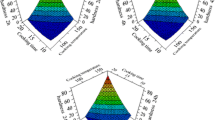Abstract
In this work the production of grape juice jellies with a low methoxyl pectin was studied. Availability of this kind of jelly will increase the range of dietetic products and is a promising alternative use for grapes surplus to the needs of the enological industry. The formulation of the jellies was optimized by response surface methodology (RSM), using as independent variables total sugar content (20 – 50°Brix), low methoxyl pectin content (0.5 – 1.5%) and processing temperature (55 – 90°C) at five levels. The dependent variable was the overall balance (B), a response obtained from sensory analysis. B was chosen from a series of sensory attributes evaluated by a test panel and the data treated by principal component analysis (PCA). The resulting polynomial equation (R 2 = 0.92) showed the maximum value for B to occur for a jelly produced with 38°Brix of total sugar, 1.2% of low methoxyl pectin and a processing temperature of 69°C. The sensory-optimized jelly was objectively characterized for texture and dynamic rheological behaviour.
Similar content being viewed by others
Author information
Authors and Affiliations
Additional information
Received: 2 October 1996 / Revised version: 7 January 1997
Rights and permissions
About this article
Cite this article
Sousa, I., Matias, E. & Laureano, O. The texture of low calorie grape juice jelly. Z Lebensm Unters Forsch 205, 140–142 (1997). https://doi.org/10.1007/s002170050141
Issue Date:
DOI: https://doi.org/10.1007/s002170050141




